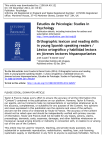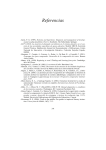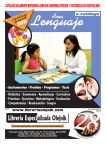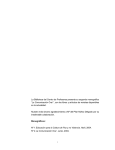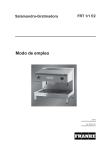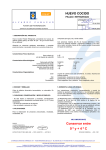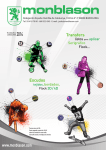Transcript
READING ACCURACY AND NAMING SPEED IN PRIMARY SCHOOL CHILDREN GONZÁLEZ-VALENZUELA, M.J., DÍAZ-GIRÁLDEZ F., DELGADO-RÍOS, M. and MARTÍN-RUIZ, I. Departament of Developmental and Educational Psychology. Faculty of Psychology UNIVERSITY OF MALAGA, SPAIN E-mail: [email protected] ABSTRACT The aim of this study is to determine whether naming speed predicts word reading accuracy at the beginning of primary education. The sample consists of a group of 120 students of Elementary Education, 65 boys and 55 girls, between 6 and 7 years (M= 79.79 months; SD= 3.44). The accuracy in reading words and speed of naming colors, pictures, letters and numbers were evaluated. The results of the regression analysis shows that 13% of the variance in reading accuracy is explained by the speed of naming colors, images, numbers and letters. Naming speed is a good predictor of reading accuracy even at the beginning of compulsory education. OBJECTIVE In last decades, the study of the relationship of phonological variables with reading has been a topic of great interest. Recently, studies in the literature linking the RAN with reading speed and reading accuracy at an early age in different transparent languages. Naming speed is the ability to name quickly familiar stimuli as letters, digits, numbers and colors (Wolf & Bowers, 1999) and assesses the speed and automation of cognitive processing. The RAN (Rapid Automatized Naming) is a cognitive task related to sublexical reading processes and it is related with reading accuracy of words, at early ages (Aguilar, Navarro, Menacho, Alcale Marchena and Ramiro, 2009; González, 2012), specifically, with speed of naming colors and objects (Bowey, McGuigan, and Ruschena, 2005; Wolf, Bally, and Morris, 1986). The objective of this study is to analyze the predictive nature of naming speed in the reading accuracy of words in Spanish at the beginning of primary education, particularly at age six. METHOD RESULTS PARTICIPANTS • • • • • 120 students of Elementary Education 65 boys and 55 girls, Between 6 and 7 years (M= 79.79 months; SD= 3.44). The socio-cultural level is medium-low Excluded: Students with learning disabilities, cognitive, emotional or sensory handicaps and with foreign origin with low linguistic status. INSTRUMENTS VARIABLE INSTRUMENTS Reading accuracy TEST OF READING AND WRITING LEE (Defior et al, 2006) Naming speed COMPONENTS Reading Precision • words Naming Speed • colors BATTERY RAPID NAMING • images (Gomez-Velazquez, Gonzalez-Garrido, • numbers Zarabozo and Amano, 2010) • letters The results of the multiple regression analysis are significant (F (4, 116) = 5.32 p <.005) and show that 13% of the variance in reading accuracy of words is explained by the speed of naming colors, images, numbers and letters. R R2 Images .232 .04 Letters .270 Numbers Colors F B β t 6.596 -.095 -.232 -2.56 .06 9.271 -.307 -.270 -3.04** .245 .05 7,504 -.435 -.245 -2.73* .320 .09 13,365 -.202 -.320 -3.65** **p<.005; *p<.01; The results of the simple regression showed the speed of naming colors and letters are the components that explain better the reading accuracy of words at this age, by 9 and 6%, respectively (F (1, 118) = 13.36 y F (1, 119) = 9.27, p < .005). PROCEDURE The design of this study is cross-sectional. The reading accuracy of words and naming speed was individually assessed in the school of children. The correction of tests and the data processing were done by psychologists of the research group. DISCUSSION • The results show that RAN predicts reading accuracy of words at the beginning of the compulsory education. • The naming speed of letters and colors are the factor that explain it better. • These results support other studies that link closely the RAN with reading accuracy (Aguilar et al., 2012; Cardoso-Martín and Pennington, 2004; Georgiou and Parrila, 2006; Kirby, Georgiou, Martinussen and Parrila, 2010). • RAN is important in the prevention and intervention of learning disabilities at an early age and in transparent languages , such as Spanish. • In futures studies, we want to analyze the influence of the RAN in the reading accuracy of pseudowords compulsory education. and in the second years of REFERENCES Aguilar, M. Navarro, J. I., Menacho, I. Alcale, C., Marchena, E., & Ramiro, P. (2012). Velocidad de nombrar y conciencia fonológica en el aprendizaje inicial de la lectura. Psicothema, 22(3), 436-442. Bowey, J.A., McGuigan, M., & Ruschena, A. (2005). On the association between serial naming speed for letters and digits and wordreading skill: Towards a developmental account. Journal of Research in Reading, 28(4), 400–422. Cardoso-Martins, C., & Pennington, B. F. (2004). The relationship between phoneme awareness and rapid serial naming skills and literacy acquisition: The role of developmental period and reading ability. Scientific Studies of Reading, 8, 27–52. Defior Citoler, S. A.; Fonseca L.; Gottheil, B. y col. (2006). LEE: Test de lectura y escritura en español: 1º a 4º de educación primaria: manual técnico. Buenos Aires, Paidós. Georgiou, G.K., & Parrila, R., & Kirby, J. (2006). Rapid Naming Speed components and early reading acquisition. Scientific Studies of Reading, 10(2), 199-220. Gómez-Velázquez, F.R. González-Garrido, A.A., Zarabozo, D., Amano, M. (2010). La velocidad de denominación de letras. El mejor predictor temprano del desarrollo lector en español. Revista Mexicana de Investigación Educativa, 15(46), 823-847. González, M. J. (Coord) (2012). Prevención de las dificultades de aprendizaje. Madrid: Ediciones Pirámide. Kirby, K.R., Georgiou, G.k., Martinussen, R., and Parrila, R. (2010). Naming speed and reading: From prediction to instruccion. Reading Research Quarterly, 45(3), 341-362. Wolf, M., Bally, H., & Morris, R. (1986). Automaticity, retrieval processes, and reading: A longitudinal study in average and impaired readers. Child Development, 57(4), 988–1000.
